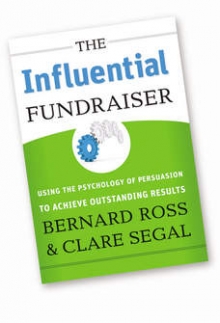The Influential Fundraiser: Using the psychology of persuasion to achieve outstanding results, by Bernard Ross and Clare Segal

We are all social animals and our thinking and behaviour can be greatly influenced by those around us. This book explains how to apply the psychology of persuasion to crafting fundraising appeals. It therefore holds appeal not only to fundraisers but also to those philanthropists who wish to understand the logic behind the appeals they receive.
The authors translate existing scientific knowledge on human behaviour into practical tips for fundraisers. The content is derived from different disciplines including ‘cognitive behaviour therapy’, which offers insights into the way people make choices; ‘social anthropology’, which examines body language and its impact on rapport building; 'psychology therapy’, which highlights skills and insights on empathetic matching and pacing; and other academic research that explains how to make a lasting positive impact on others. In a sense the phrase "psychology of persuasion" is a little misleading because not all the tips focus on persuading people to donate. Rather, Ross and Segal encourage fundraisers to consider the donor perspective, in order to change the way they think about and behave towards them. In this sense The Influential Fundraiser reads a little like a self-help book because it is largely about how one’s behaviour can influence others.
The authors simplify the psychological concepts in a neat system comprising five alliterative steps (or ‘cogs’) that lead to successful fundraising. The first of the ‘five p’s’ is ‘passion’, which concerns both the fundraiser’s emotional engagement with the cause and understanding the donor’s motivations. The second is ‘proposal’ which offers advice on improving the case for support. The third, ‘preparation’, focuses on ‘shaping outcomes’ and building self-confidence. The fourth step or cog is ‘persuasion’, which explains techniques that can help with building rapport, speaking the language of influence and understanding the donor’s point of view. The final part, ‘persistence’ shares advice on helping donors to say ‘yes’ to a request for support and offers suggestions for dealing with objections should they say ‘no’.
Ross and Segal identify nine different types of ‘no’, only one of which actually means, "no, go away", leaving eight negative responses that can be turned around if the fundraiser understands the nature of the objection and how to use their influence to overcome it. For example: "no, you’ve asked at the wrong time’"or "no, you’ve asked for too much". The latter objection is accompanied by a very neat piece of wisdom: “If you ask for the gift and they fall off the chair, you’ve asked for too much. If you ask for the gift and they don’t fall off their chair, you didn’t ask for enough”.
Such ‘insider advice’ from the profession of fundraising may make this book potent in donors’ hands because techniques only work if the subject is unaware of them, and many of today’s philanthropists are savvy enough to recognise the mechanics of the asking process, however much science they draw upon.
Four appendices offer advice on how to read eye cues, use richer language, personalise a case for support and use influencing techniques in group situations. This is all helpful advice that may improve fundraising success.
In terms of ease of reading, this book is clear and userfriendly, if a little simple. It would have been nice to know more about the science behind the practical advice, as was promised in the introductory chapter. Also, more discussion about the role others can play in influencing helping behaviour would have been invaluable.
There are a number of social psychology experiments which examine the influence of others on increasing and decreasing the chances someone will help; for example the ‘bystander effect’ which states that the presence of others can decrease helping behaviour, due to ‘diffused responsibility, social loading, audience inhibition and social influence’. However, the presence of others, especially the feeling of being watched by others, can also increase helping behaviour. Recently, psychologists found that feelings of being watched can increase charity donations –to the extent that the image of a pair of eyes on charity websites can increase giving behaviour!
This book does not claim to be an academic reference book, but rather a practical guide with tips, based on psychological science. The use of real life anecdotes and scenarios make this a very engaging book to read. It also proves that academic research on human behaviour has much to offer fundraisers, and it is great to see a book try to bridge the gap between academic theory and practical everyday implementation.
However, it does raise ethical concerns, treading a fine line between manipulation and persuasion. As the authors state: “If you feel like you are manipulating someone, then you probably are. So stop whatever you are doing.” The focus of this book is more about helping those asking for money to think about their own behaviour and cognition than manipulation of others. Nevertheless, if you are interested in more information or want to enter into dialogue on the ethics of persuasion I recommend that you go to the book’s website. I suspect it would be particularly valuable for donors, such as the readers of the Philanthropy UK Newsletter, as well as fundraisers to join the debate this book has begun.




